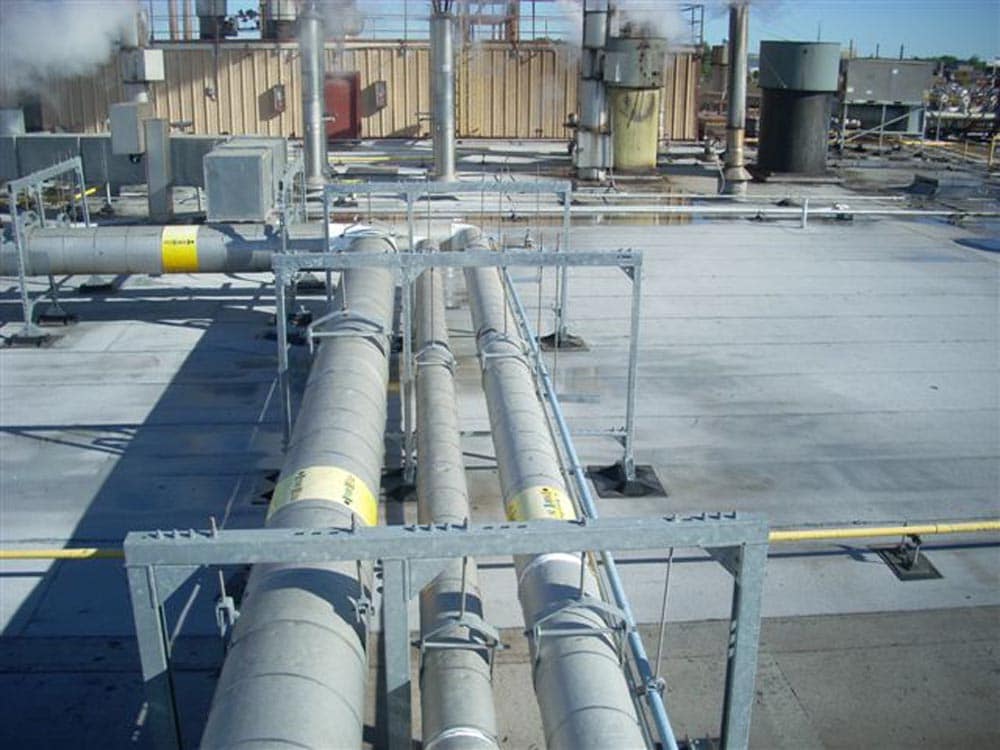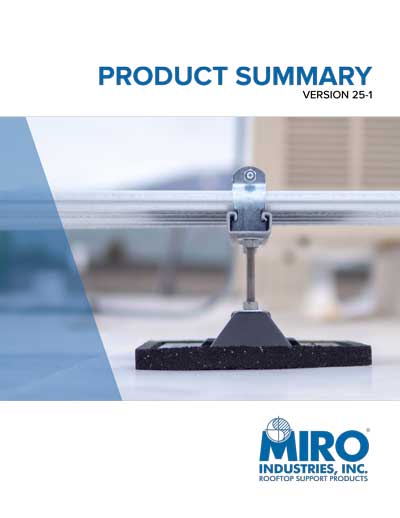When it comes to rooftop systems, the way pipes are supported can make the difference between a reliable installation and costly repairs. Without proper supports, pipes can sag, shift, or damage the roof surface, leading to leaks, safety hazards, and premature failures. Hanging pipe supports are specifically engineered to prevent these problems by keeping piping secure, aligned, and able to move where necessary. This guide covers the basics of pipe hangers and supports, the different types available, and best practices for choosing the right solution.
What Are Rooftop Pipe Supports?
Rooftop pipe supports are structural components that hold pipes above the roof surface. Their job is to distribute weight evenly, prevent direct contact with the roof membrane, and maintain alignment. A pipe hanger support also reduces vibration, accommodates thermal expansion, and protects the roof from unnecessary wear. Without them, even well-installed piping can put stress on the roofing system and shorten its lifespan.
Hanger Pipe Supports
Hanger pipe supports suspend pipes from above, holding them securely in place while keeping them off the roof surface. They are commonly used for HVAC, plumbing, and electrical conduit runs.
Advantages
- Simple height and slope adjustments
- Help maintain pitch for drainage
- Keep piping organized and clear of obstructions
Limitations
- Require a structural point to suspend from
- Can be more complex to install on rooftops compared to surface-mounted supports
Types of Pipe Hangers and Supports
There are several options to consider when selecting pipe hangers and supports for rooftop systems. Each has its own strengths depending on the application.
Clevis Pipe Hanger
A clevis pipe hanger is one of the most common and cost-effective options. It provides dependable support while allowing easy pipe height adjustments without removal. This makes it ideal for sloped applications. However, clevis hangers may not perform as well in seismic or high-wind conditions.
Pipe Roller Hangers
Pipe roller hangers work like clevis hangers but include a roller that allows the pipe to move forward and backward. This design accommodates thermal expansion and contraction, reducing stress on the system. They’re excellent for systems exposed to temperature fluctuations, though they share similar limitations in seismic environments.
Roller Chairs
Roller chairs allow pipes to move lengthwise but not side-to-side. They’re especially useful in new construction projects where multiple pipes are installed together. While adjustments can be trickier, roller chairs can be adapted for seismic or wind use with straps.
Trapeze Pipe Hanger
A trapeze pipe hanger supports multiple pipes at once, making it a great option for complex rooftop layouts. It allows for slight adjustments and is quick to install. The downside is the potential for point loading, where weight is concentrated in one area, requiring careful planning.
Roller Pipe Supports
While hangers suspend pipes, roller pipe supports sit beneath them and allow movement. These are essential for long runs where pipes expand and contract due to temperature changes.
Applications
- Steam and hot water systems
- Chilled water lines
- Piping exposed to thermal fluctuations
Advantages
- Reduce stress from thermal movement
- Prevent buckling or roof penetration
- Extend service life of the system
Limitations
- Require precise alignment for proper function
- May need more frequent inspection than fixed supports
Non-Penetrating vs. Penetrating Designs
Pipe hanger support systems generally fall into two categories:
Non-Penetrating Supports
- Sit on bases or pads that spread weight without puncturing the roof membrane
- Protect against leaks and are easy to reposition
- Best suited for flat membrane roofs
Penetrating Supports
- Anchored directly into the structure for permanent stability
- Handle heavier loads but pose a leak risk if not sealed correctly
The choice depends on building type, load requirements, and long-term maintenance considerations.
Compliance & Safety Considerations
Pipe hangers and supports aren’t just about convenience; they’re also about compliance. Standards such as OSHA and the International Building Code (IBC) establish safety and structural requirements. Meanwhile, SMACNA guidelines outline best practices for types of pipe hangers and supports used in mechanical systems. Ensuring compliance reduces liability and inspection issues.
Best Practices for Choosing the Right Support
When selecting rooftop hanging pipe supports or pipe roller hangers, keep these factors in mind:
- Load Capacity: Supports must match pipe size and weight.
- Thermal Expansion: Choose roller supports or expansion joints for systems with temperature fluctuations.
- Roof Type: Flat, sloped, or green roofs may call for different solutions.
- Durability: Materials should resist UV, corrosion, and weather exposure.
- Maintenance: Opt for supports that are easy to inspect and adjust.
Common Mistakes to Avoid
- Using makeshift materials like wood blocks instead of engineered supports
- Ignoring thermal expansion in long pipe runs
- Overloading supports beyond their rating
- Poor spacing or misalignment during installation
These mistakes can lead to roof damage, inefficiency, and expensive repairs.
Conclusion
Choosing the right pipe hangers and supports is essential for protecting both piping and rooftops. From the versatility of the clevis pipe hanger to the efficiency of the trapeze pipe hanger and the flexibility of pipe roller hangers, each option serves a unique purpose. By carefully matching the hanger support pipe system to your application and following best practices, you’ll extend the lifespan of your rooftop systems, improve safety, and reduce long-term costs.
—————————————————————————
MIRO is here to help. Request a Quote for project pricing, or book a Free Rooftop Design Consultation to get expert guidance on the best support system for your needs.


